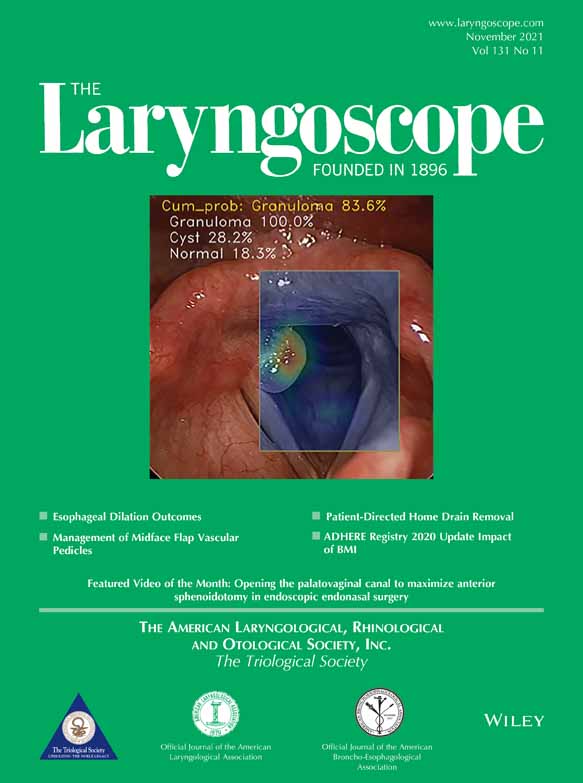Recurrent Laryngeal Nerve Monitoring in Pediatric Surgery Using a Modified Dragonfly Electrode
Editor's Note: This Manuscript was accepted for publication on February 20, 2021.
The authors have no funding, financial relationships, or conflicts of interest to disclose.
Abstract
INTRODUCTION
The recurrent laryngeal nerve (RLN) is at risk during pediatric surgery of the neck, mediastinum, and chest. RLN injury during surgery for esophageal atresia, tracheoesophageal fistula, and tracheobronchomalacia (TBM) is established in the literature as the RLN often courses through the operative field. Identifying and protecting the RLN is particularly difficult in the surgery of neonates, aberrant anatomy, and in reoperative cases.1, 2
Intraoperative nerve monitoring (IONM) is standard of practice in adult thyroid surgery but has not yet been widely adopted in pediatric surgery.3 An obstacle to routine utilization of IONM in pediatric surgery is the lack of size-appropriate nerve monitoring devices for the pediatric patient. Translaryngeal and endolaryngeal electrodes may be used in small infants, but they are associated with significant challenges. Translaryngeal electrodes may obstruct the surgical field. Endolaryngeal electrodes may be difficult to place, cause trauma, or dislodge with positioning or intraoperative bronchoscopy. Endotracheal tubes (ETTs) with integrated or adhesive electrodes are the most common way to monitor the RLN. Single channel adhesive electrodes are available for ETT as small as 2.0 mm inner diameter (ID) but do not allow for monitoring of each nerve individually. Thus, if one nerve is injured intraoperatively, the surgeon may not be alerted by the system because the contralateral nerve is functioning. Double-channel electrodes allow for monitoring of each nerve individually. Unfortunately, integrated and adhesive double-channel electrodes (monitor each RLN separately) are only available in ETT appropriate for children aged 4 years or older. We present a modification of a double-channel adhesive electrode for IONM of the RLN in children as young as term infants.
METHODS
This study was approved by the institutional review board of Boston Children's Hospital. Retrospective chart review was performed of the case described below.
Surgical Technique
For all cases of intraoperative RLN monitoring, chemical paralysis must be avoided and preoperative communication between the surgical and anesthesia teams is vital. An appropriately sized standard ETT is selected for the patient down to a size 3.0 mm ID (term infant). As the electrode slightly increases the outer diameter of the ETT, the ETT may need to be downsized to prevent excessive pressure on the larynx and subglottis. A Neurovision Dragonfly Stick-On double-channel electrode of small size (Neurovision Medical Products, Ventura, California) is then custom trimmed to fit the smaller ETT. The Dragonfly adhesive electrodes are compatible with both Neurovision's Nerveana Nerve Locator and Monitor system (Neurovision Medical Products, Ventura, California) and the Medtonic Nerve Integrity Monitoring (NIM) systems (NIM 3.0 and NIM Vital, Medtronic, Jacksonville, Florida).
The Dragonfly double-channel sensor is trimmed by the surgeon, otolaryngologist, or anesthesiologist. Depending on the size of the ETT, there are two different ways to trim the sensor. For a smaller ETT (3.0 or 3.5), the two lateral electrodes are trimmed such that the two center channels or electrodes remain in line with the adhesive tape, resulting in a significantly narrower double-channel electrode (Figure 1). For an ETT sized 4.0 or 4.5, a single lateral electrode is cut off, leaving three active electrodes on the sensor (two of the same color). Regardless of how the sensor is trimmed, a voltmeter is then used to determine which leads are active (Figure 2). The inactive leads are marked by placing a small knot on them to avoid connecting them to the NIM system. If a voltmeter is not available, one can unravel the cords to determine which electrodes are active (Figure 3). Once the active leads are determined, the trimmed sensor is wrapped around the desired ETT. Care is taken to place the electrode proximal to the cuff (if using a cuffed tube) at the approximate level that the vocal folds will lie after intubation (Figure 4).
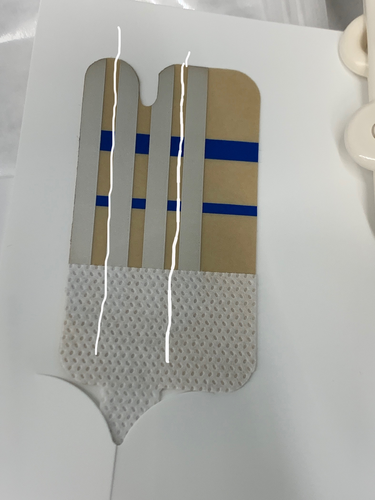
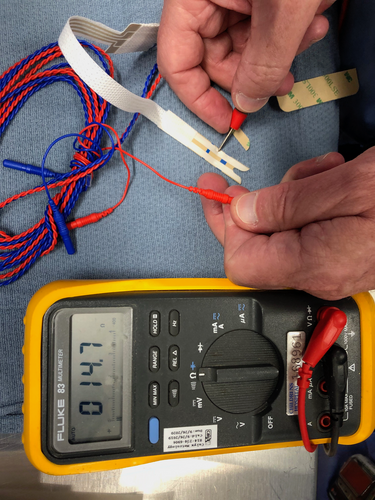
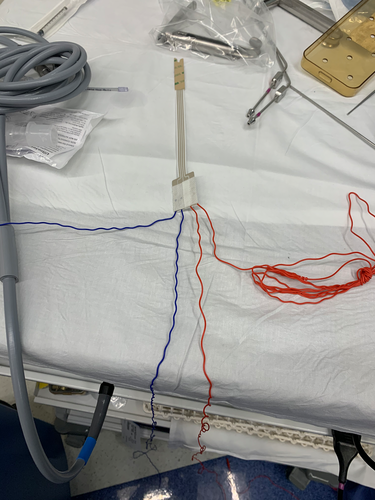
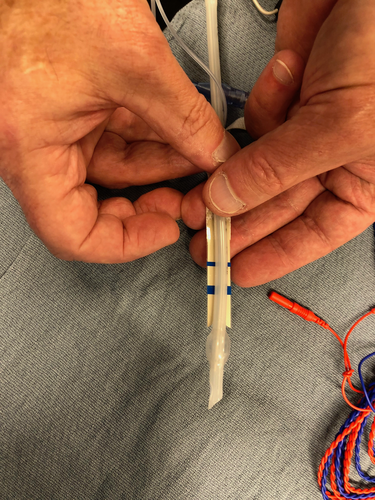
The patient is then intubated by the anesthesia or surgical team using a concurrent media access control (KARL STORZ SE & Co. KG, Tuttlingen, Germany) blade. The two horizontal blue lines on the sensor help to mark the midpoint of the electrodes which should contact the true vocal folds. The tube is then secured by anesthesia. The electrode needles of the additional (one or two depending on how the sensor was trimmed) active electrodes (to replace those tied off and not used on the Dragonfly) are placed into the anterior neck near the thyroid cartilage to ensure function of the double-channel system (Figure 5). Two grounding leads (one for the surface electrode system and one for the stimulator) are placed into muscle such as the deltoid or trapezius. The Dragonfly electrode is then connected to the nerve monitoring system of choice and a baseline amplitude should read for each vocal fold individually. Function of the system is ultimately confirmed by stimulation of each nerve individually with a nerve probe once the surgical field is open. It is important to note that the nerve monitoring systems will still function after the electrode has been modified if it is set up appropriately, though this is not a manufacturer-approved modification.
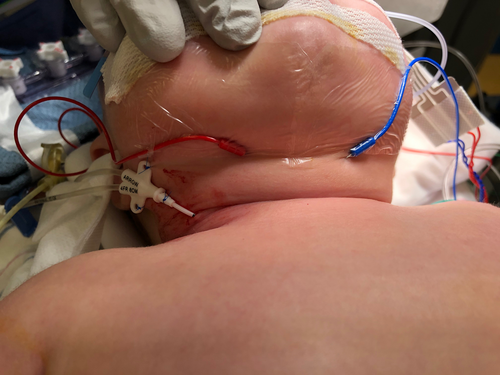
Troubleshooting
- No signal: Check all electrodes are connected appropriately and that impedance levels are less than 1 Ω. If impedance levels are greater than one then that particular electrode needs to be placed closer to the operative field and/or deeper within the tissues. Perform video-laryngoscopy to ensure sensors are truly at the level of the vocal cords. Make sure receiver box has a working fuse.
- Nerve will not stimulate: Perform a video laryngoscopy to ensure the electrodes are positioned on the vocal folds.
- Excessive background noise: Ensure silencer is wrapped around electrocautery cord.
- Loss of signal: Evaluate entire system
RESULTS
A 4-month-old girl with severe TBM and brief resolved unexplained events underwent posterior tracheopexy, bilateral bronchopexies, rotation esophagoplasty, and partial thymectomy via right thoracotomy. Bilateral RLNs were at risk during the procedure. A Dragonfly stick on double-channel electrode was modified as described above and wrapped around a 3.5 cuffed ETT. Function of the nerve monitoring system was confirmed with stimulation of bilateral RLN using a nerve probe intraoperatively. Her preoperative and postoperative flexible fiberoptic laryngoscopy showed normal vocal fold movements bilaterally.
DISCUSSION
We present a novel technique for adapting double-channel electrodes that adhere to ETTs for monitoring the RLN in infants and small children. IONM provides immediate feedback to the surgeon on RLN location and function during surgery. IONM yields three surgical advantages: identification of the RLN, aid in dissection, and prognostication of post-operative neural function and lesion site identification. In adult patients, IONM demonstrates a 99% negative predictive value and 75% positive predictive value of intraoperative nerve signaling loss and post-operative vocal fold paralysis.5
Challenges inherent to IONM using this technique include those inherent to integrated ETT electrodes: improper placement of the EMG electrodes (too proximal, too distal, or rotated) thus poor detection of vocal fold stimulation, providing the surgeon with a false negative response and no ability to monitor RLN function which can result in unexpected postoperative nerve injury. The ETT may move with manipulation of the patient's head and neck even after adequate placement is confirmed during laryngoscopy. In addition, if the nerve is accidentally transected, the surgeon may only notice after the injury when the audible and visual warning is elicited from the NIM system. Conversely, the system may register stimulation of the nerve when the surgeon is not operating near the nerve (false positive) or provide noisy signal feedback inhibiting accurate monitoring. In addition, adhesive electrodes may slip, especially during long procedures with prolonged exposure to airway secretions, resulting in loss of nerve monitoring.



